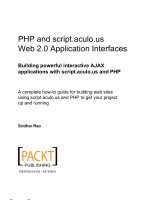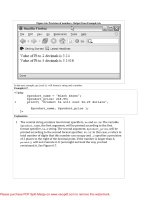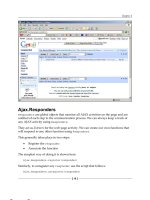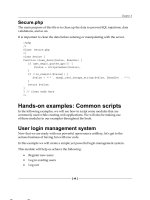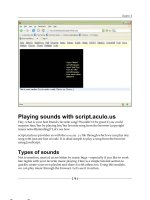Tài liệu PHP and MySQL by Example- P9 pptx
Bạn đang xem bản rút gọn của tài liệu. Xem và tải ngay bản đầy đủ của tài liệu tại đây (1.91 MB, 50 trang )
&
Even though there is only one image, when the user clicks somewhere on it, the accompanying form will be sent to the
server with the location of where the user clicked his or her mouse on the picture; that is, the pixel coordinates
represented as two variables in the PHP script, image_name_x and image_name_y (image_name is the name
assigned to the name attribute of the image input type; that is, toy_x and toy_y). The actual variable names sent by
the browser contain a period rather than an underscore (toy.x and toy.y) but, as we discussed earlier in this chapter,
PHP will automatically convert a period (or space) to an underscore because periods (and spaces) are not legal
characters in PHP variable names. In the following example, after the user clicks on any of the check boxes, he or she
will then click on the picture of the pizza man. This causes the form to be submitted with an array of values selected
from the check boxes, as well as the x/y coordinates of where the user clicked on the image button.
Example 10.14.
Code&View:&
(The HTML File)
<html> <head><title>Image Button</title> </head>
<body bgColor="#CCFF33">
<font face="verdana"><b>
1 <form method="post" action="image_button.php" >
Pick your pizza:<p>
2 <input type="checkbox"
name="topping[]"
value="tomatoes" />Tomato and Cheese<br />
<input type="checkbox"
name="topping[]"
value="salami" />Salami<br />
<input type=checkbox
name="topping[]"
value="pineapple" />Pineapple and Ham<br />
<input type=checkbox
name="topping[]"
value="Canadian bacon" />Canadian bacon<br />
<input type=checkbox
name="topping[]"
value="extra cheese" />Plain Cheese<br />
<p><font size="-1">
Press the pizza man to order!
<br />
3 <input type="image" name="pizzas" src="Pizza_chef.jpg" />
<br /><br />
<input type=reset value="Clear the form" />
</form>
</body>
</html>
(The PHP Script)
<html><head><title>Finding Pixel Coordinates</title></head>
<body bgcolor="8CCCCA">
<br />
<fieldset><legend><b>Pizza Choices</b></legend>
<?php
4 if ($_POST['topping']){
Please purchase PDF Split-Merge on www.verypdf.com to remove this watermark.
print "<ul>";
5 foreach ( $_POST['topping'] as $value ){
print "<li>$value</li>";
}
print "</ul>";
}
print "The pixel coordinates of the image are: <br />";
6 $coord1 = $_POST['pizzas_x'];
$coord2 =
$_POST['pizzas_y'];
print "$coord1, $coord2<br />";
?>
</fieldset>
</body>
</html>
Explanation
1
The&form,&shown&in&Figure&10.23,&is&being&submitted&to&a&PHP&script&using&the&
POST&method.
2
The&form&consists&of&a&set&of&check&boxes&that&will&be&passed&to&PHP&as&an&array&
called&"topping".
3
Here&is&where&we&create&the&image&button&to&be&used&to&submit&the&form.&It&is&
given&a&name&of&"pizzas"&and&the&image&src&is&"Pizza_chef.jpg"&located&in&
the¤t&working&directory&or&folder.&When&the&user&clicks&on&this&picture,&
the&form&will&be&submitted.
4
If&the&user&has&posted&the&form,&there&will&be&a&value&in&the&$_POST&array,&the&
expression&will&test&true,&and&the&block&will&be&entered.
5
For&each&of&the&toppings&in&the&$_POST&array,&the&values&will&be&printed.&See&
Figure&10.24.
6
The&x/y&coordinates&represent&the&place&in&the&image&(pixel&position)&where&
the&user&clicked&his&or&her&mouse&button.&To&check&whether&or¬&the&form&
was&submitted,&you&can&test&if&these&variables&are¬&empty&with&the&empty()&
function:&if ( ! empty($coord1 )
&
Please purchase PDF Split-Merge on www.verypdf.com to remove this watermark.
Figure 10.23. PHP output after processing multiple selections.
&
Figure 10.24. Using an image to submit a form.
&
Please purchase PDF Split-Merge on www.verypdf.com to remove this watermark.
Figure 10.25. After the form input has been processed, the user’s choices are listed as well as the pixel positions
of the image button (the pizza man).
&
&
&
10.3.10. Self-Processing HTML Forms
Rather than creating a separate HTML document to display a form and another PHP script to process the user input, you
might want to combine the HTML document containing the form and the PHP script that processess it all into one
script. This is done by assigning the $_SERVER['PHP_SELF'] array to the action attribute of the HTML
<form> tag as shown in Example 10.15. When the user submits the form information by pressing the submit button,
the action attribute of the form references the URL of the same page that displayed the form. Because both the
HTML form data and the PHP processing code are in the same script, you will need a conditional check in your PHP
program to see if the form has been submitted. For example, you can check to see if a field has a value, the submit
button has been clicked, or check the request method used. The following examples demonstrate how this is done.
Checking If the Form Was Submitted
Example 10.15 shows the script that checks whether a form was submitted.
Example 10.15.
Code&View:&
<?php
1 if ( isset($_POST['submit'])){ // Was the form submitted?
2 $your_name=$_POST[your_name];
$your_phone=$_POST[your_phone];
print "<b>Your name is $your_name<br />";
print "Your phone is $your_phone<br />";
3 print "The path to this file is: ".
$_SERVER['PHP_SELF']."<br />";
}
4 else{ ?>
<html><head><title>First HTML Form</title></head>
<body bgcolor="lightblue"><font size="+1">
5 <form action="<?php echo $_SERVER['PHP_SELF']; ?>"
method="POST">
Please purchase PDF Split-Merge on www.verypdf.com to remove this watermark.
<p />
6 Please enter your name: <br />
<input type="text" size=50 name="your_name">
<p />
Please enter your phone: <br />
<input type="text" size=50 name="your_phone">
<p />
<input type="submit" name="submit" value="Send Now">
<input type=reset value="Clear">
</form>
<hr>
</html>
<?php } ?>
Explanation
1
The&PHP&isset()&function&checks&to&see&if&the&form&has&been&submitted&using&
the&POST&method.&If&it&has,&the&program&continues&at&line&2;&if¬,&then&program&
control&goes&to&line&4,&and&the&form&will&be&displayed&in&the&browser.
2
Because&the&form&has&already&been&submitted,&the&values&that&were&entered&
into&the&fields&can&be&displayed&as&variables.&See&Figure&10.27.
3
The&superglobal&$_SERVER['SELF']&array&contains&information&about&the&path&
where&this&script&is&found&starting&at&the&document&root&of&the&server,¬&the&
root&of&the&file&system.
4
If&the&form&has¬&been&submitted,&the&script&jumps&into&this&block&where&we&
switch&from&PHP&into&the&HTML&mode&to&produce&the&form.&See&Figure&10.26.
5
The&action&attribute&is&assigned&the&address&of&the¤t&script.&The&
program&temporarily&switches&back&into&PHP&mode&to&get&the&path&of&the&script&
from&the&$_SERVER['PHP_SELF']&variable.&When&the&user&presses&the&submit&
button,&this&same&script&will&be&reexecuted,&this&time&to&process&the&form&data.
6
The&user&is&presented&with&two&text&boxes,&as&shown&in&Figure&10.26.
Please purchase PDF Split-Merge on www.verypdf.com to remove this watermark.
Figure 10.26. The script displays the form.
&
Figure 10.27. The same script processes the form.
&
&
&
10.3.11. Using Hidden Fields
If your Web page contains multiple forms, you can use hidden fields to help identify what form needs to be processed
by giving each form its own name. By checking the existence and value of the hidden field, you can determine which
form should be displayed and when it should be processed.
You can also use hidden fields to include information that can be used when processing the form but is not something
that you do not care to display, such as the date the form was created, your name, and so on.
Example 10.16.
Code&View:&
<html><head><title>Hidden Fields</title></head>
<body bgcolor="#ff66ff">
Please purchase PDF Split-Merge on www.verypdf.com to remove this watermark.
<font face="verdana">
<div align="center">
<b>
<?php
1 if (isset($_POST['feedback1']) && ($_POST['feedback1'] ==
'process_form1')){
process_form1();
}
2 else{
display_form1();
}
3 function display_form1(){
4 echo <<<EOF
5 <form action="$_SERVER[PHP_SELF]" method="post">
Rate this page
<br /><b /r>
<input type="radio" name="rating" value="excellent"
/>Really kewl
<input type="radio" name="rating" value="average" />OK
<input type="radio" name="rating" value="poor" />Boring
<input type="radio" name="rating" value="hopeless"
/>Totally hopeless
6 <input type="hidden" name="feedback1"
value="process_form1">
7 <input type="hidden" name="creation_date"
value="Feb.
2006" />
<p>
<input type="submit" value="submit rating" />
<input type="reset" value="clear" />
</form>
8 EOF;
}
9 function process_form1(){
echo "So you think this page is $_POST[rating]!";
}
?>
</b>
</div>
</body>
</html>
&
&
&
Please purchase PDF Split-Merge on www.verypdf.com to remove this watermark.
Explanation
1
The&isset()&function&will&check&to&see&if&the&variable&$_POST['feedback1']&
has&been&set&and&if&it&contains&the&value&assigned&to&the&hidden&field.&If&both&
conditions&are&true,&then&the&form&has&already&been&displayed&on&the&browser&
and&sent&back&to&this&PHP&script.&Because&the&page&has&already&been&displayed&
and&submitted,&it&is&now&time&to&process&the&form.&The&userYdefined&function,&
process_form(),&is&called.
2
If&the&test&on&line&1&fails,&then&the&form&has¬&been&previously&displayed.&The&
userYdefined&function,&display_form(),&is&called.
3
The&function&display_form()&will&be&responsible&for&creating&the&form&and&
displaying&it&in&the&browser.
4
This&is&the&start&of&a&hereYdoc&used&to&print&out&the&HTML&form&and&interpolate&
any&variables.&Remember&that&when&in&a&hereYdoc&you&are&essentially&in&a&
quoted&block&of&text.&Adding&additional"es&to&the&array&elements&will&
produce&an&error.
5
The&$_SERVER['PHP_SELF']&is&a&reference&to&the¤t&script.&When&the&user&
presses&the&submit&button,&the&action&is&specified&to&call&this&same&script&again.
6
The&hidden&field&is&set&as&an&input&type&of&the&<form>&tag.&Although&it&will¬&
be&visible&when&the&form&is&displayed,&its&name&and&value&will&be&sent&to&the&
PHP&script,&along&with&the&name&and&value&of&the&radio&button&selected&by&the&
user.
7
The&hidden&field&is&assigned&the&month&and&year&when&this&form&was&created.&
No&one&needs&to&see&this&information,&except&maybe&you&if&you&are&trying&to&
keep&track&of&the&development&of&this&page.
8
The&userYdefined&terminator,&EOF,&for&marking&the&end&of&the&hereYdoc,&cannot&
have&spaces&on&either&side;&that&is,&it&must&be&butted&up&against&the&left&margin,&
immediately&followed&by&a&newline.
9
After&the&user&has&filled&out&the&form,&this&function&processes&the&input&
received&from&the&server.
Please purchase PDF Split-Merge on www.verypdf.com to remove this watermark.
Figure 10.28. Using hidden fields to determine when to process this form. Output from Example 10.16.
&
&
&
Figure 10.29. Output based on what radio button was selected in Figure 10.28.
&
&
&
10.3.12. Redirecting the User
What if your Web site has moved to a new location? Now when your users go to the old site, you want to redirect them
to the new one. What if you want to send the user to a different page depending on some condition: Is the user logged
on? Did he or she forget his or her password? What language does he or she speak? Is it a holiday?
The Location Header
Redirecting a user to another page is easy and quick with PHP. It is done with the built-in header() function to
modify the HTTP response header sent by the server. The location header can be changed by sending an HTTP
Location followed by the URL of the new location.
<?php header( 'Location: ) ; ?>
&
The header information must be sent to the browser before any HTML and text; therefore, it is important that the
header() function is executed first. The following example would be wrong because the program is trying to send
the echo output before the header information. The warning is displayed in Figure 10.30. (See “Buffering and HTTP
Headers” on page 689 if you want to move the header after other output lines.)
Please purchase PDF Split-Merge on www.verypdf.com to remove this watermark.
Figure 10.30. The header must be sent first.
&
Example 10.17.
<?php
echo "You are going to be redirected to a new page!<br />"; //
Wrong!
header("Location: /www/ellieq.com");
?>
Explanation
After being redirected, a user’s Back button will take the user where he or she was before the redirection
page, not back to the redirection page itself.
Using the Correct URI for Redirection
The Location can be assigned the absolute URI of the redirection page such as the scheme, host name, and absolute
path. Then the server will return a “redirect” header to the browser to retrieve the specified page directly.
Location:
&
If you want to reference another file on your own server, you can output a partial URL, such as the following:
Location: /tutorial/PHP/index.html
&
You can make use of PHP’s $_SERVER array variables to specify an absoute path. For example, the
$_SERVER['HTTP_HOST'], the $_SERVER['PHP_SELF'], and the path of the the current script returned by the
dirname() function can be concatenated together to make an absolute URL from a relative one. The following PHP
code defines a header described in the PHP manual:
<?php header("Location: http://" . $_SERVER['HTTP_HOST']) .
dirname($_SERVER['PHP_SELF']) . "/my_newpage.php"); ?>
&
If you are redirecting a user to a new Web site, it is also a good idea to let him or her know what is happening by adding
a line such as “Our site has moved. You will automatically be redirected there.”
Please purchase PDF Split-Merge on www.verypdf.com to remove this watermark.
Example 10.18.
Code&View:&
(The HTML File)
<html><head><title>Redirecting the User</title></head>
<body bgcolor="#33ff33">
1 <form action="http://localhost/exemples/ch10forms/redirect.php"
method="post">
<b>
Select a search engine<br />
</b>
2 <select name="new_url">
<option value="" />Google
<option value="" /> Yahoo!
<option value="" /> Lycos
<option value="/index.php" /> PHP Index
</select>
3 <input type="submit" value=" Get the Web Page!" />
</form>
</body>
</html>
(The PHP Script)
<?
4 if($_POST[new_url] == ""){
exit;
}
else {
5 header("Location: $_POST[new_url]");
exit;
}
?>
Explanation
1
The&form’s&action&attribute&is&assigned&the&path&to&the&PHP&script&that&will&handle&the&
redirect&once&the&form&is&submitted.&The&HTML&form&is&shown&in&Figure&10.31.
2
The&HTML&select&menu&will&give&the&user&options&to&choose&from.
3
As&soon&as&the&user&clicks&the&submit&button,&the&form&information&will&be&sent&to&the&
server&and&handled&by&the&PHP&script&listed&in&the&form’s&action&attribute.
4
If&the&user&did¬&select&anything,&the&value&of&$_POST[new_url]&will&be&empty,&and&the&
script&will&exit.
5
If&the&user&selected&one&of&the&search&engines&in&the&menu&(Figure&10.32),&he&or&she&will&
be&directed&to&that&Web&site&with&the&PHP&header()&function.&The&value&of&
$_POST[new_url]&is&the&address&of&the&selected&Web&site;&for&example,&
.&Once&the&user&is&redirected,&he&or&she&can&use&the&brower’s&Back&
button&to&go&back&to&the&page&where&the&selection&was&made.
Please purchase PDF Split-Merge on www.verypdf.com to remove this watermark.
button&to&go&back&to&the&page&where&the&selection&was&made.
&
Figure 10.31. The HTML Web page before viewing the menu and selecting an option.
&
&
&
Figure 10.32. The user selects “PHP Index” from the drop-down menu and presses “Get the Web Page!” to
redirect to that site.
Please purchase PDF Split-Merge on www.verypdf.com to remove this watermark.
10.3.13. Uploading Files
In an HTML form, users can upload files from a browser to a Web server. The files might be text files, binary files
(such as images or compressed files), spreadsheets, or other data (see Being
able to upload files is also useful if the information is easier to handle from a separate file, such as a registration form or
a résumé. To upload files, you will need to create a form using the "file" type.
Attributes for the <Form> Tag and the file Type
To upload files the <form> tag has three attributes:
• The action attribute of the <form> tag specifies the PHP script that will process the form.
• The enctype attribute determines how the form data is encoded by the browser. The default value is
application/x-www-form-urlencoded, which is the default for almost any kind of form data.
However, if you are going to upload files then you must specify that the data is of enctype multi-
part/form-data. The browser encodes form data differently for application/x-www-form-
urlencoded and multipart/form-data.
• The method attribute should be "POST".
Example 10.19.
(Sample File Upload Form Values)
1 <form enctype="multipart/form-data"
2 action="PHPscript.php"
3 method="POST">
<! MAX_FILE_SIZE is optional and must precede the file input
field >
4 <input type="hidden" name="MAX_FILE_SIZE" value="30000" />
5 Choose a file to upload: <input name="uploadfile" type="file"
/>
<input type="submit" value="Send File" />
</form>
In addition to the three attributes, the form’s input type is "file"; for example:
<input type="file" name="uploadfile"
&
With an input type of type "file", the browser might show a display of (previously selected) file names, and a
Browse button or selection method. Selecting the Browse button would cause the browser to enter into a file selection
mode, allowing you to select from a list of files from different directories or folders. See Figure 10.34.
You can also specify the MAX_FILE_SIZE field size, the maximum number of bytes that will be accepted, but this
only advises what size the file should be. This cannot be larger than upload_max_filesize defined in the
php.ini file (default 2MB). Note also that this hidden field must precede the file input field in the HTML.
Files will, by default, be stored in the server’s default temporary directory, unless another location has been given with
the upload_tmp_dir directive in php.ini. You can use the built-in move_uploaded_file() function to
store an uploaded file somewhere permanently (see Example 10.21).
From the php.ini file:
Code&View:&Scroll&/&Show&All&
; File Uploads ; ;;;;;;;;;;;;;;;; ; Whether to allow HTTP file uploads.
file_uploads = On ; Temporary directory for HTTP uploaded files (will use
system default if not ; specified). upload_tmp_dir = "c:/wamp/tmp" ; Maximum
allowed size for uploaded files. upload_max_filesize = 2M
&
Please purchase PDF Split-Merge on www.verypdf.com to remove this watermark.
PHP’s $_FILES Array
When the file is sent to the server, PHP stores all the uploaded file information in the $_FILES superglobal array (see
Table 10.3), a two-dimensional array that contains the name of the file input device as the first index and one of the
attributes of the file type as the second index.
Table 10.3. The $_FILES Superglobal Array
Array
Description
$_FILES['userfile']['name']
The&original&name&of&the&file&on&the&client&machine.
$_FILES['userfile']['type']
The&MIME&type&of&the&file,&if&the&browser&provided&this&
information.&An&example&would&be&"image/gif".
$_FILES['userfile']['size']
The&size,&in&bytes,&of&the&uploaded&file.
$_FILES['userfile']['tmp_name']
The&temporary&filename&of&the&file&in&which&the&
uploaded&file&was&stored&on&the&server.
$_FILES['userfile']['error']
The&error&code&associated&with&this&file&upload.&
['error']&was&added&in&PHP&4.2.0.
&
Example 10.20.
Code&View:&
(The HTML File)
<html><head><title>Uploading Files</title></head>
<body bgcolor="lavender">
<h3>Uploading Files</h3>
1 <form
2 enctype="multipart/form-data"
3 action="upload_file.php"
4 method="post">
Type the name of the file to upload: <br />
5 <input name="user_file"
type="file"/>
<br />
<input type=submit value="Get File"/>
</form>
</body>
</html>
(The PHP Script upload_file.php)
<?php
6 $handle=fopen($_FILES['user_file']['tmp_name'], "r");
7 while(!feof($handle)){
8 $text=fgets($handle);
echo $text,"<br />";
}
?>
Please purchase PDF Split-Merge on www.verypdf.com to remove this watermark.
Explanation
1
The&form&starts&here&and&is&displayed&in&Figure&10.33.
2
The&attribute&to&the&form&type&is&enctype&and&assigned&"multipart/form-
data".&This&encoding&type&is&used&to&send&data&from&files.
3
The&action&attribute&specifies&the&PHP&script&that&will&process&the&uploaded&
files.
4
Uploaded&files&must&be&sent&via&the&POST&method.
5
The&input&device&is&of&type&"file"&and&will&be&assigned&the&name&"user_file".&
The&name&is&how&the&uploaded&file&will&be&identified&in&the&PHP&file,¬&the&
real&name&of&the&file.&See&Figure&10.35.
6
The&$_FILES['user_file']['tmp_name']&array&holds&the&name&of&the&
temporary&file&that&PHP&gave&to&the&uploaded&file.&The&fopen()&function&will&
open&that&file&for&reading&and&return&a&filehandle&that&allows&access&to&the& file.&
(See&“The&fopen()&Function”&on&page&448.)
Figure 10.33. The file upload form from Example 10.20 in the browser.
&
&
&
&
Please purchase PDF Split-Merge on www.verypdf.com to remove this watermark.
&
&
Figure 10.34. The user selects the Browse button in the form.
&
&
Figure 10.35. The user then selects a file.
&
&
Moving the Uploaded File
PHP provides the move_uploaded_file() function to move an uploaded file to a new location.
Please purchase PDF Split-Merge on www.verypdf.com to remove this watermark.
Format
bool move_uploaded_file ( string filename, string destination )
This function checks to ensure that the file designated by filename is a valid upload file (meaning that it was uploaded
using the POST method). If the file is valid, it will be moved to the filename given as a destination.
If the filename is not a valid upload file, then no action will occur, and move_uploaded_file() function will
return FALSE with a warning.
Example 10.21.
Code&View:&
(The HTML Form)
<html><head><title>Uploading Pictures</title></head>
<body bgcolor="lavender">
<h3>Uploading Files</h3>
<form
1 enctype="multipart/form-data"
action="upload_move_file.php"
method="post">
Browse and select the picture you want to upload: <br />
2 <input name="picture_file" type="file" />
<br />
<input type=submit value="Get File"/>
</form>
</body>
</html>
(The PHP Script)
<html><head><title>File Uploads</title></head>
<body bgcolor="#33ff33">
<font face="verdana" size="+1">
<?php
echo "The uploaded file is: ", $_FILES['picture_file']
['tmp_name'], "<br />";
$filename=$_FILES['picture_file']['name'];
$filesize=$_FILES['picture_file']['size'];
$directory='c:/wamp/www/exemples/formsphp/
picture_uploads/';
3 $uploadFile = $directory . $filename;
echo "The moved file is: $uploadFile<br />";
4 if (move_uploaded_file($_FILES['picture_file']['tmp_name'],
$uploadFile)){
echo "The file is valid and was successfully uploaded.
<br /> ";
echo "The image file, $filename, is $filesize bytes.<br
/>";
}
?>
<center>
Please purchase PDF Split-Merge on www.verypdf.com to remove this watermark.
<br />
<img src=<?php
echo "/exemples/formsphp/picture_uploads/$filename";?>
width="250" height="175" border="3">
</center>
</font>
</body>
</html>
Explanation
1
To&upload&files&the&encoding&type&must&be&"multipart/form-data"&and&the&
method,&POST.
2
The&uploaded&file&must&be&of&type&"file".&Its&name&is&"picture_file",&the&name&
used&to&identify&the&file&in&the&$_FILES[]&associative&array.&The&file&being&
uploaded&is&shown&in&Figure&10.36.
3
The&variable,&$uploadFile,&contains&the&directory&and&filename&to&where&the&
picture&will&be&moved.
4
The&move_uploaded_file()&function&moves&the&uploaded&file&to&its&new&location.&
Its&first&argument&is&the&original&file&and&its&second&argument&is&the&destination.
Figure 10.36. Uploading and moving Images.
&
Please purchase PDF Split-Merge on www.verypdf.com to remove this watermark.
10.3.14. Sticky Forms
A sticky form is a form that remembers the values you typed in the input fields. A typical example is when you fill out a
form to purchase some products or fill out a registration form and you left out a field or typed the credit card
information wrong. When you submit the order, the page comes back with the form and tells you what you did wrong
and asks you to resubmit the order. If the order form is long and contains lots of boxes, how many times will you
resubmit it, if you have to start all over again? With a sticky form, the input data can be saved so that when the form is
redisplayed, the data is still there. The following example checks if the user left any fields empty and if he or she did,
redisplays the form with an error showing what fields need to filled. The fields that had data in them still contain the
data. (For a complete discussion on form validation, see Chapter 12, “Regular Expressions and Pattern Matching.”)
Example 10.22.
Code&View:&
<html><head><title>Empty Fields</title>
<body><div align="center">
<h2>Validating Input</h2>
<?php
1 $errors=array();
2 if(isset($_REQUEST['submit'])){ // If the form was
submitted
3 validate_input(); // Check for empty fields
4 if(count($errors) != 0){ // If there are errors,
// redisplay the form
display_form();
}
5 else{ echo "<b>OK! Go ahead and Process the form!</b>
<br />"; }
}
6 else{display_form();} // Display the form for the first
time
7 function validate_input(){
8 global $errors;
if($_POST["name"] == ""){
9 $errors['name']="<font color='red'>
***Your
name?***</font>";
}
if($_POST["phone"] == ""){
$errors['phone']="<font color='red'>
***Your phone?***</font>";
}
}
10 function display_form(){
global $errors;
?>
<b>
11 <form method="post"
action="<?php echo $_SERVER['PHP_SELF'];
?>">
What is your name? <br />
12 <input type="text" name="name"
value="<?php echo $_POST[name]; ?>">
Please purchase PDF Split-Merge on www.verypdf.com to remove this watermark.
<br />
13 <?php echo $errors['name']; ?>
<br />
What is your phone number?<br />
<input type="text" name="phone"
value="<?php echo $_POST[phone]; ?>">
<br />
14 <?php echo $errors['phone']; ?>
<br />
<input type="reset">
<input type="submit" name="submit">
<br />
<form>
<?php
}
?>
</b>
</div>
</body>
</html>
Explanation
1
The&$errors&array&is&initialized.&It&will&be&used&to&build&a&string&error&
message.
2
If&the&isset()&function&returns&true,&the&user&has&already&submitted&the&form&
and&program&control&will&go&to&line&3.
3
The&userYdefined&function,&validate_input(),&is&called.
4
If&the&PHP&count()&function&finds&that&the&$errors&array&is¬&empty,&the&
display_form()&function&is&called&and&the&same&form&is&displayed&again&with&
the&error&messages&displayed&in&red.&See&Figures&10.38&and&10.39.
5
If&there&are&no&errors,&then&the&form&will&be&processed.&We&do¬&do&any&real&
processing&here,&but&if&we&did,&this&is&where&the&code&would&go.
6
If&line&1&is&false&(i.e.,&the&form&has¬&yet&been&displayed),&the&form&will&be&
shown&in&the&browser&for&the&first&time.
7
This&is&a&userYdefined&function&that&will&determine&whether&or¬&the&user&
filled&in&the&required&fields.
8
The&global&keyword&makes&this&array&available&within&the&function.
9
If&the&user&did¬&fill&the&"name"&field,&the&$errors&array&will&be&assigned&a&
string&of&text&as&its&value.&The&key&'name'&is&the&name&of&the&text&box.
10
This&function&displays&the&form,&as&displayed&in&Figure&10.37.
Please purchase PDF Split-Merge on www.verypdf.com to remove this watermark.
11
The&form&is&a&selfYprocessing&form&when&the&action&attribute&
$_SERVER[PHP_SELF]&is&assigned&this&value.
12
When&the&input&type&is&named,&the&value&given&to&it&will&be&empty&the&first&
time&it&is&displayed&because&PHP&has¬&yet&processed&the&input.&If&the&form&
has&already&been&displayed&and&there&was&an&error,&then&the&value&of&the&field,&
if&there&was&one,&will&be&assigned&by&switching&over&to&PHP&mode&and&using&
the&value&of&$_POST[name].&This&is&what&makes&the&form&“sticky.”&If&the&user&
had&typed&his&or&her&name,&PHP&would&have&put&the&value&back&in&the&text&
box,&but&if&the&user&did¬&type&his&or&her&name,&the&value&of&$_POST[name]&
will&be&empty&and¬hing&will&be&restored&to&the&text&box.&Instead&the&user&
will&see&an&error&in&red&text&as&shown&on&line&13.
13
If&the&user&did¬&enter&his&or&her&name&in&the&text&box&field,&this&error&will&be&
printed&right&below&it.&If&the&user&did&enter&his&or&her&name,&the&value&in&this&
array&element&will&be&empty&and¬hing&will&be&printed.
14
If&the&user&did¬&enter&his&or&her&phone&number&in&the&text&field&box,&an&
error&will&be&printed,&as&shown&in&Figure&10.38.
Figure 10.37. The initial HTML form from Example 10.22.
&
Please purchase PDF Split-Merge on www.verypdf.com to remove this watermark.
Figure 10.38. The user left one field empty.
&
&
&
Figure 10.39. The user left both fields empty.
&
&
10.3.15. Where to Get Information About Superglobal Arrays
As we have seen throughout this chapter, PHP superglobal arrays (also called autoglobal), such as _GET and _POST
are defined as part of the global namespace of your PHP script and used to store the user input coming from HTML
forms. Other superglobals, such as the server’s configuration, cookies, or information about the environment are also
accessible in your PHP script in superglobal arrays. These predefined arrays are referred collectively as EGPCS
(Environment, GET, POST, Cookie, and Server information). They are called superglobals because they are available in
every part of your program. (Cookies are discussed in Chapter 16, “Cookies and Sessions.”)
The phpinfo() Function
To see the available predefined variables on your system, you can use the phpinfo() function that includes not only
all of the EGPCS information, but a huge amount of information about PHP, such as version, operating system,
environment, compilation options, server information, HTTP headers, and so on. Table 10.4 lists arguments used to
Please purchase PDF Split-Merge on www.verypdf.com to remove this watermark.
customize the output of the phpinfo() function. You can use either the constant value in column 1 or the number
value in column 2. Column 3 describes the output. In the following example phpinfo() displays the EGPCS
predefined variables.
<?php phpinfo(INFO_VARIABLES); // phpinfo(32) does the same thing ?>
&
Table 10.4. phpinfo() Options
[a]
Name#(Constant)
Value
Description
INFO_GENERAL
1
The&configuration&line,&php.ini&location,&build&date,&Web&
server,&system,&and&more.
INFO_CREDITS
2
PHP&credits.&See&also&phpcredits().
INFO_CONFIGURATION
4
Current&local&and&master&values&for&PHP&directives.&See&also&
ini_get().
INFO_MODULES
8
Loaded&modules&and&their&respective&settings.&See&also&
get_loaded_extensions().
INFO_ENVIRONMENT
16
Environment&variable&information&that&is&also&available&in&
$_ENV.
INFO_VARIABLES
32
Shows&all&predefined&variables&from&EGPCS&(Environment,&
GET,&POST,&Cookie,&Server).
INFO_LICENSE
64
PHP&License&information.&See&also&the&license&FAQ.
INFO_ALL
–1
Shows&all&of&the&above.&This&is&the&default&value.
&
[a]
From For a complete list and definitions see
10.3.16. How to Get Server Information
We have been working with HTML forms and PHP, going back and forth between the server and browser. PHP makes
information about your server available to your scripts. The Web server assigns values to the PHP superglobal
$_SERVER array such as header, path, script locations, and version information. All servers are not consistent in the
information they provide. Table 10.5 defines some of the superglobals (from the PHP manual) you will encounter in the
following chapters. See Figure 10.40 for a partial output.
Table 10.5. Retrieving Server Information
$_SERVER#Key
Description#of#Value
PHP_SELF
The&filename&of&the¤tly&executing&script,&relative&to&the&document&
root.&For&instance,&$_SERVER['PHP_SELF']&in&a&script&at&the&address&
/>The&__FILE__&constant&contains&the&full&path&and&filename&of&the&
current&(i.e.,&included)&file.
GATEWAY_INTERFACE
The&CGI&specification&the&server&is&using&(i.e.,&CGI/1.1).
Please purchase PDF Split-Merge on www.verypdf.com to remove this watermark.
Table 10.5. Retrieving Server Information
$_SERVER#Key
Description#of#Value
SERVER_NAME
The&name&of&the&server&host&under&which&the¤t&script&is&
executing.&If&the&script&is&running&on&a&virtual&host,&this&will&be&the&value&
defined&for&that&virtual&host.
SERVER_SOFTWARE
Server&identification&string,&given&in&the&headers&when&responding&to&
requests.
SERVER_PROTOCOL
Name&and&revision&of&the&information&protocol&via&which&the&page&was&
requested&(i.e.,&HTTP/1.0).
REQUEST_METHOD
Which&request&method&was&used&to&access&the&page&(i.e.,&GET,&HEAD,&POST,&
PUT).
REQUEST_TIME
The×tamp&of&the&start&of&the&request.&Available&since&PHP&5.1.0.
QUERY_STRING
The&query&string,&if&any,&via&which&the&page&was&accessed.
DOCUMENT_ROOT
The&document&root&directory&under&which&the¤t&script&is&
executing,&as&defined&in&the&server’s&configuration&file.
HTTP_ACCEPT
Contents&of&the&Accept:&header&from&the¤t&request,&if&there&is&one.
HTTP_CONNECTION
Contents&of&the&Connection:&header&from&the¤t&request,&if&there&is&
one.&Example:&Keep-Alive.
HTTP_HOST
Contents&of&the&Host:&header&from&the¤t&request,&if&there&is&one.
HTTP_REFERER
The&address&of&the&page&(if&any)&that&referred&the&user&agent&to&the&
current&page.&This&is&set&by&the&user&agent.&Not&all&user&agents&will&set&
this,&and&some&provide&the&ability&to&modify&HTTP_REFERER&as&a&feature.&
In&short,&it&cannot&really&be&trusted.
HTTP_USER_AGENT
Contents&of&the&User-Agent:&header&from&the¤t&request,&if&there&is&
one.&A&typical&example&is:&
Mozilla/4.5 [en] (X11; U; Linux 2.2.9 i586)
&
See&also&the&get_browser()&function.
REMOTE_ADDR
The&IP&address&from&which&the&user&is&viewing&the¤t&page.
REMOTE_HOST
The&host&name&from&which&the&user&is&viewing&the¤t&page.&The&
reverse&DNS&lookup&is&based&off&the&REMOTE_ADDR&of&the&user.
REMOTE_PORT
The&port&being&used&on&the&user’s&machine&to&communicate&with&the&
Web&server.
Please purchase PDF Split-Merge on www.verypdf.com to remove this watermark.
Table 10.5. Retrieving Server Information
$_SERVER#Key
Description#of#Value
SCRIPT_FILENAME
The&absolute&pathname&of&the¤tly&executing&script.&Note:&If&a&
script&is&executed&with&the&CLI,&as&a&rela t ive&path,&such&as&file.php&or&
/file.php,&$_SERVER['SCRIPT_FILENAME']&will&contain&the&relative&
path&specified&by&the&user.
SERVER_PORT
The&port&on&the&server&machine&being&used&by&the&Web&server&for&
communication,&default&is&port&80;&using&SSL&is&your&defined&secure&
HTTP&port.
SERVER_SIGNATURE
String&containing&the&server&version&and&virtual&host&name&that&are&
added&to&serverYgenerated&pages,&if&enabled.
PATH_TRANSLATED
The&path&of&the&file&system&(not&document&root)&related&to&the¤t&
script.
SCRIPT_NAME
Contains&the¤t&script’s&path.&This&is&useful&for&selfYprocessing&
pages.&The&__FILE__&constant&contains&the&full&path&and&filename&of&the&
current&(i.e.,&included)&file.
REQUEST_URI
The&URI&that&was&given&to&access&this&page;&for&instance,&/index.html.
Please purchase PDF Split-Merge on www.verypdf.com to remove this watermark.
